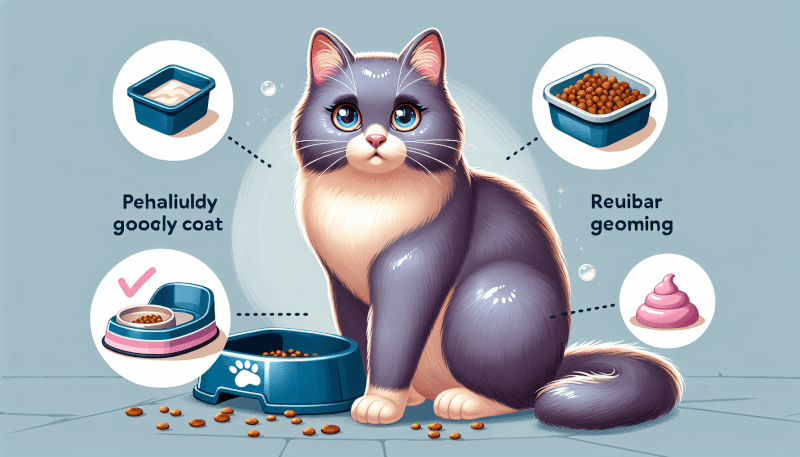You’re a proud cat owner, and knowing whether your feline companion is in good health is of utmost importance to you. In this article, we will explore the telltale signs that indicate a cat’s wellbeing. By keeping an eye out for these indicators, you can ensure that your beloved kitty is happy, content, and thriving. So, without further ado, let’s delve into the fascinating world of cat health and discover the signs of a healthy cat. When it comes to assessing the overall health of your furry feline friend, there are several key physical and behavioral signs to look out for. By paying attention to these indicators, you can ensure that your cat is in optimal health and provide them with the care they need. Let’s explore each of these signs in detail, so you can have a better understanding of what to look for in your cat’s well-being.
Physical Appearance
Clear Eyes
One of the first things you should observe is your cat’s eyes. A healthy cat will have clear, bright eyes without any signs of discharge or redness. Clear eyes are an indication of good overall health, as they show that your cat’s immune system is functioning well and that there are no underlying infections or diseases.
Shiny Coat
A lustrous and vibrant coat is another tell-tale sign of a healthy cat. Touch and observe your cat’s fur regularly to ensure that it feels smooth and soft. A shiny coat is a result of a balanced diet, proper grooming, and overall good health. If you notice any dullness, excessive shedding, or patches of fur missing, it may be an indication of an underlying health issue that requires attention.
Healthy Weight
Maintaining a healthy weight is crucial for cats. An optimal body weight helps to prevent various health problems such as diabetes and arthritis. You should be able to feel your cat’s ribs without applying excessive pressure, as this indicates that they are at an ideal weight. If you notice significant weight loss or gain, it is advisable to consult with your veterinarian for a proper assessment and guidance on managing your cat’s weight.
Clean Ears
Take a closer look at your cat’s ears – they should be clean, free from wax buildup, and have no signs of redness or swelling. Ears that are itchy, irritated, or emit a foul odor may be indicative of an ear infection or infestation of parasites. If you notice any unusual discharge or if your cat seems bothered by their ears, it is essential to have them examined by a veterinarian to determine the cause and provide appropriate treatment.
Behavioral Signs
Lively and Playful
A healthy cat is often full of energy, curiosity, and enthusiasm, displaying a lively and playful demeanor. They engage in regular exercise, explore their environment, and actively interact with their surroundings. If your cat seems lethargic, uninterested in their usual activities, or shows a drastic change in behavior, it could be a sign of an underlying health issue and should be investigated further.
Good Appetite
A healthy cat will have a healthy appetite. They should eagerly approach their food and finish their meals without any difficulty. Keep an eye out for any sudden changes in eating habits, such as loss of appetite or excessive overeating, as these may indicate a potential health concern. It’s important to monitor their food intake and consult with your veterinarian if you notice any significant changes.
Normal Sleep Patterns
Cats are renowned for their love of sleep, and it’s perfectly normal for them to spend significant portions of the day napping. However, it’s important to be aware of their sleep patterns. A healthy cat will have a balanced sleep-wake cycle, waking up regularly for meals, playtime, and social interaction. If your cat exhibits abnormal sleep patterns, such as excessive sleeping or insomnia, it may be a sign of an underlying health issue that requires attention.
Digestive System
Regular Bowel Movements
A healthy cat will have regular bowel movements, typically once or twice a day. Their stool should be firm, well-formed, and easy to pass without straining. If you notice any changes in your cat’s bowel movements, such as diarrhea, constipation, or an increased frequency, it could signify an underlying gastrointestinal problem.
Solid Stools
In addition to regular bowel movements, it’s important to observe the consistency of your cat’s stools. Healthy cats generally have firm, solid stools that hold their shape. Loose or watery stools may be a sign of dietary allergies, infections, or other gastrointestinal issues. Keep an eye out for any changes in stool consistency and consult with your veterinarian if you have concerns.
No Vomiting
Occasional hairballs aside, a healthy cat should not experience frequent vomiting. Vomiting can be a sign of various health issues, including gastrointestinal disorders and dietary intolerances. If your cat vomits regularly or displays other accompanying symptoms, such as loss of appetite or lethargy, it’s crucial to seek veterinary advice to determine the cause and provide appropriate treatment.
Respiratory System
Normal Breathing
A healthy cat should exhibit normal and unlabored breathing patterns. Their breaths should be quiet, smooth, and free from any wheezing or labored sounds. Rapid or shallow breathing, coughing, or excessive sneezing can be indicators of respiratory problems that require immediate veterinary attention.
Clear Nose
A cat’s nose should be moist and clear, without any excessive discharge or discoloration. While it’s normal for a cat’s nose to vary in temperature throughout the day, a consistently dry or warm nose may warrant further investigation. If your cat displays nasal congestion, difficulty breathing through their nose, or any other nasal abnormalities, consult with your veterinarian for a proper diagnosis and treatment.
Cardiovascular System
Strong Heartbeat
A strong heartbeat is a crucial indicator of a healthy cardiovascular system. While it may be challenging to detect your cat’s heartbeat without veterinary equipment, you can observe their overall activity level and stamina. A healthy cat will have good endurance, engage in regular physical activity without tiring easily, and exhibit a strong pulse.
Good Capillary Refill Time
Capillary refill time is a useful indicator of cardiovascular health. By pressing gently on your cat’s gums, you can check how quickly the color returns after releasing the pressure. In healthy cats, the gums should return to their pink color within two seconds. Prolonged capillary refill time may suggest a problem with circulation and warrants further investigation by a veterinarian.
Oral Health
Pink Gums
Healthy gums in cats should be pink in color, not overly pale or excessively red. Gums that appear inflamed, swollen, or bleeding may indicate gum disease or other oral health issues. Regularly check your cat’s gums for any abnormalities and consult with your veterinarian if you notice any concerning changes.
Clean Teeth
Just like humans, cats require dental care to maintain good oral health. Healthy cats should have clean teeth without excessive tartar buildup or signs of decay. Brushing your cat’s teeth regularly, providing dental treats or toys, and scheduling routine professional dental cleanings can all contribute to their oral well-being. If you notice any signs of dental pain or discomfort, consult with your veterinarian for appropriate dental care advice.
Fresh Breath
A healthy cat should have fresh breath, free from any foul odor. While it’s not uncommon for cats to occasionally experience temporary bad breath, persistent halitosis may be a sign of underlying dental or gastrointestinal issues. If your cat’s breath consistently has an unpleasant odor, it is advisable to have them examined by your veterinarian.

Urinary System
Normal Urination
Observing your cat’s urination habits is vital for assessing their urinary health. A healthy cat should urinate regularly, without any signs of straining or discomfort. Pay attention to the frequency and volume of urine produced, as well as any changes in urination behavior. If you notice any significant deviations from your cat’s normal urinary patterns, such as increased or decreased urination, it may be indicative of a urinary tract infection or other urinary issues.
Yellow or Clear Urine
The color of your cat’s urine can provide valuable insights into their hydration and urinary health. In general, a healthy cat’s urine should be a pale yellow color and relatively clear. Dark, cloudy, or bloody urine can be a sign of dehydration, urinary tract infections, or other urinary problems. Keep an eye on your cat’s urine and consult with your veterinarian if you have any concerns about its appearance or smell.
Musculoskeletal System
Active and Agile
Cats are known for their grace and agility, and a healthy cat should exhibit excellent mobility and be nimble in their movements. They should be able to run, jump, and engage in various physical activities without showing signs of discomfort or lameness. If you observe any limping, stiffness, or reluctance to move, it is essential to have your cat examined by a veterinarian to evaluate their musculoskeletal health and address any potential issues.
No Lameness
Lameness refers to difficulty or pain in using one or more limbs. A healthy cat should walk and move freely without any noticeable abnormalities in their gait or posture. If you notice your cat favoring or avoiding one limb, hesitancy in jumping or climbing, or any signs of lameness, it may indicate a musculoskeletal problem that requires attention.
Reproductive System
No Abnormal Discharge
Female cats should not have any abnormal discharge from their reproductive tract. Discharge that appears bloody, excessive, or has an unusual odor may indicate an infection or other reproductive health issue. If you observe any concerning discharge, it’s crucial to seek veterinary guidance to ensure the well-being of your cat.
No Swollen Mammary Glands
For female cats who have not been spayed, it is important to monitor their mammary glands for any signs of swelling or abnormalities. Swollen mammary glands may indicate a hormonal imbalance or potentially indicate the presence of mammary tumors. Regularly examining your cat’s mammary glands and promptly reporting any changes to your veterinarian can help ensure timely detection and treatment.
Nervous System
Responsive to Stimuli
A healthy cat has a responsive and alert nervous system. They should react appropriately to visual and auditory stimuli, showing curiosity and interest in their environment. If your cat seems unresponsive, lethargic, or displays abnormal reactions to stimuli, it may suggest a possible neurological issue that requires veterinary evaluation.
Normal Gait
Cats are known for their elegant and balanced movements. A healthy cat will generally have a smooth and coordinated gait, with all four limbs moving in a synchronized manner. If you notice any difficulties or abnormalities in your cat’s gait, such as stumbling, staggering, or limping, it’s essential to consult with your veterinarian. These signs may indicate neurological problems or musculoskeletal issues that should be addressed promptly.
Keeping a vigilant eye on these various signs can help you ensure the health and well-being of your furry companion. Remember, every cat is unique, and it’s important to establish a baseline for what is normal for your cat’s physical appearance and behavior. By regularly monitoring these indicators and seeking veterinary advice when needed, you can provide the best care and attention to your beloved feline friend.


